ORTHOPEDY
These are the 15 most common orthopaedic conditions.
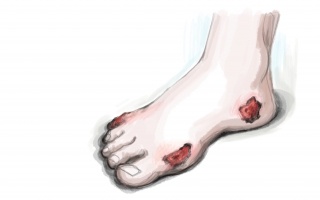
DIABETES FOOT
The feet of a diabetic patient are very fragile. Because the feeling in the feet decreases, small wounds can easily occur. The patient does not feel when a shoe pinches too hard, for example. This causes wounds that are very difficult to heal and can cause serious inflammation.
The solution for diabetes feet is semi-orthopaedic shoes, possibly in combination with adapted orthotic inlays. It is very important to check your feet properly and always consult your doctor in case of infections. Never play doctor yourself. It can save you a lot of trouble!

DROP FOOT
People with a drop foot, also known as a hanging foot or a drag foot, cannot lift the forefoot or do not lift it sufficiently. As a result, the foot often hits the ground hard and audibly. This foot abnormality often occurs after a brain haemorrhage (C.V.A.) and is caused by weakened muscles and the loss of certain nerves. In addition, this abnormality is often accompanied by the so-called ‘steppage’ gait. The knee is lifted higher than normal to prevent the foot from dragging over the ground.
The treatment consists of several factors. On the one hand, direct pressure on the nerve must be avoided and attention paid to the posture of the body. Stretching exercises can also be performed. Sturdy and comfortable footwear is also recommended. In most cases, a drop foot recovers after two to three months. In serious cases with paralysis, physiotherapy and/or an ankle-foot orthotic inlay is the correct treatment, but full recovery is not always possible.
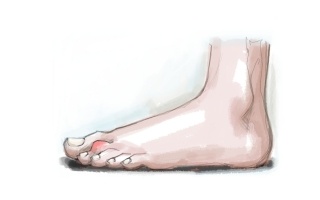
HAMMER TOES
The toes of a claw foot are often in a claw-like position, hence: claw or hammer toes (medical name: digitus malleus). Hammer toes are a very frequent phenomenon from the second to the fifth toe. In the beginning, the malformations are supple and easy to treat. However, they become increasingly stiff and uncorrectable. Hammer toes are accompanied by calluses and corns where the malformations come into contact with footwear that is too narrow or where the pressure is too great.
As long as the hammer toes are still flexible and there are no infections or wounds, a support sole or specific silicone orthotic inlay can be a solution. If the pain and deformity persist, a surgical procedure can provide relief.
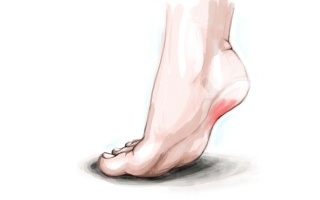
HEEL SPURS
Someone who suffers from heel spurs experiences a shooting and nagging pain at the base of the heel, especially in the morning and towards the evening. Heel spurs are therefore caused by an inflammation on the rim of the foot that runs from the bottom of the heel bone up to and including the toes. It is often the result of overweight, overloading or stiffness of the Achilles tendon.
The treatment of heel spurs consists of several stages. First of all, inlays are strongly recommended, whether or not in combination with anti-inflammatory drugs (in consultation with the doctor). Stretching exercises are also very important. In rare serious cases, a surgical procedure is chosen.
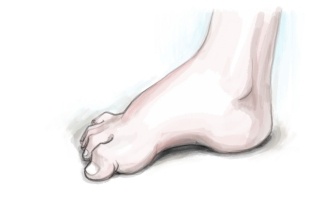
CLAW FOOT
A claw foot (medical name: pes cavus) is a foot disorder in which the arch of the foot is higher than normal. This results in a high instep, tense soles and a stretched Achilles tendon. In addition, the toes tend to adopt a claw-like position (hammer toes). Because the foot rests on the outer edge, it is turned inwards. All this can, as with most foot abnormalities, result in back, knee, hip and neck pain.
A solution to this problem? Adapted orthotic inlays for light cases or orthopaedic shoes for more serious cases. In this way, the pressure on the foot is better distributed and the foot strikes correctly.

CLUB FOOT
A club foot (medical name: equinovarus) is a congenital abnormality. Hereditary factors often play a role here. This foot disease usually involves several symptoms. First of all, the foot is in a pointing position – the foot is tilted downwards. In addition, the foot is also tilted inwards. And finally, the forefoot points inwards and the Achilles tendon is too short.
In the case of club feet, massage, plastering and/or taping of the feet is carried out as soon as possible after birth. Without the desired result, an operative Achilles tendon extension and/or metatarsophalangeal correction must be carried out. In later life, orthopaedic shoes are the best alternative.

BUNIONS
With a bunion (medical name: hallux valgus) the position of the big toe deviates from the normal position. The big toe starts to grow in the direction of the small toe. This causes a lump on the side of the foot at the base of the big toe. This lump can eventually lead to inflammation and pain.
In the case of a hallux valgus, the patient is usually predestined to get this abnormality. Wearing unsuitable footwear, such as shoes that are too narrow or too high heels, can lead to pain and inflammation in the case of bunions.
There are three possible treatments for hallux valgus. For less pronounced bunions, comfort footwear with adapted orthotic inlays is sufficient. In severe cases, orthopaedic shoes or a surgical procedure are the solution.

METATARSALGIA
Metatarsalgia is a broad term for all kinds of forefoot complaints. In this condition, the patient experiences load pain in the ball of the foot, where the toes begin. Calluses at these pressure points are often a signal for metatarsalgia. The condition can also manifest itself in other ways, such as the development of hammer toes, the dislocation of a toe, a stress fracture, etc. There are several causes for this abnormality: a shortened Achilles tendon, sagging of the foot, hallux valgus, certain claw feet, etc.
The best treatment is a combination of carrying out stretching exercises and wearing suitable orthotic inlays. In severe cases, a surgical procedure should be considered.
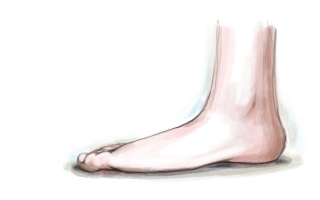
FLAT FOOT
With a flat foot (medical name: pes planus) the arch of the foot is lower than normal. The arch of the foot has subsided, so that it rests partly or completely on the ground. This can lead to pain in the knee, back or hip. There are two types of flat feet: supple and stiff.
A supple flat foot, better known as an articulated foot, is not in itself something to worry about. It is caused by muscle tension and the size of the bones. Due to a slackening of the muscles and the ligaments between the lower leg and the foot, the foot bends inwards. This is a natural phenomenon until the age of 6, after which the feet should be in a normal position. Stiff flat feet, on the other hand, are often the result of a congenital abnormality. Furthermore, rheumatism or osteoarthritis can also be the cause of this foot disorder.
A supple flat foot can become a problem when the muscles and ligaments are severely weakened and they can no longer keep the bones in the correct position. Adapted orthotic inlays that distribute the pressure better can provide relief. For stiff flat feet, the best treatment is to wear custom-made orthopaedic shoes.

SESAMOIDITIS
Sesamoiditis involves inflamed tissue around the sesamoid bones. These two small bones are located under the joint between the big toe and the forefoot. They play an important role in the development of the foot. The inflammation can be the result of overloading or damage, and can cause a lot of pain and discomfort.
Depending on the cause, overload or a break, several solutions are possible: taping/felt padding, comfortable footwear with a low heel and a wide top, but especially adapted orthotic inlays are a good remedy.
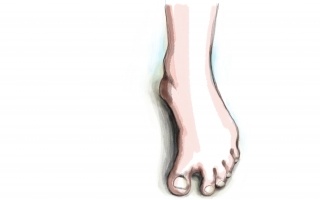
SICKLE FOOT
A sickle foot (medical name: pes adductus) often goes hand in hand with a hallux varus. In this condition, the big toe deviates from its straight axis towards the other foot.
If this varus position of the big toe is noticed quickly, the taping of the big toe is the most appropriate treatment. Furthermore, adapted orthopaedic footwear with a wide tip and little friction is a good solution. In severe cases, a surgical procedure is an option.
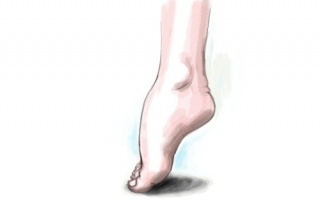
POINTED FOOT
In the case of a pointed foot (medical name: pes equinus), the position of the foot deviates from the normal position. The position of the foot is in line with that of the lower leg. This deviation can be the result of prolonged bed-rest, a nervous disorder or muscular disease. In addition, a pointed foot can also be caused by paralysis, or it can be congenital.
Appropriate exercises are a good treatment, but in severe cases a surgical procedure on the lower leg may be necessary.
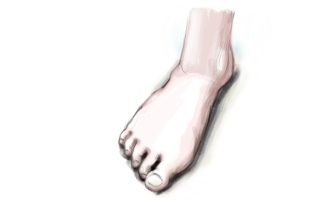
SPLAYED FOOT
A splayed foot (medical name: pes planotransversus) can be considered as the precursor of the bunion. With a splayed foot there is pain in the front of the foot. The cause is a sagging forefoot arch and weakened metatarsals as a result of rheumatism or a congenital defect. Other detrimental factors are poor footwear (high heels, narrow shoes, etc.), standing upright for long periods of time or being overweight.
A splayed foot can eventually result in a bunion. It is therefore very important to wear good shoes that relieve the forefoot, with sufficient room, and in combination with orthotic inlays.
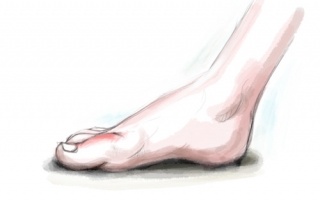
STIFF BIG TOE
With a stiff big toe (medical name: hallux rigidus) there is reduced mobility in the big toe that results in stiffening. Osteoarthritis in the big toe joint is often the cause.
A first solution to this problem consists of custom-made orthopaedic shoes. The sole of the shoe is stiffened and curved. This means that the joint no longer folds during walking and the roll-off is much easier. If pain persists, various surgical procedures are possible.

NERVE ENTRAPMENT IN THE FOOT
In this condition, a nerve is trapped between the metatarsals (medical name: Morton neuralgia). This often goes together with a splayed foot, a hollow foot or a hallux valgus. High heels can also be a cause. Anyone suffering from this disorder often suffers from tingling toes and stabbing pain in the forefoot and toes.
Adapted footwear is recommended, but especially pressure-relieving orthotic inlays are a must. In very serious cases, surgical intervention may be considered.
